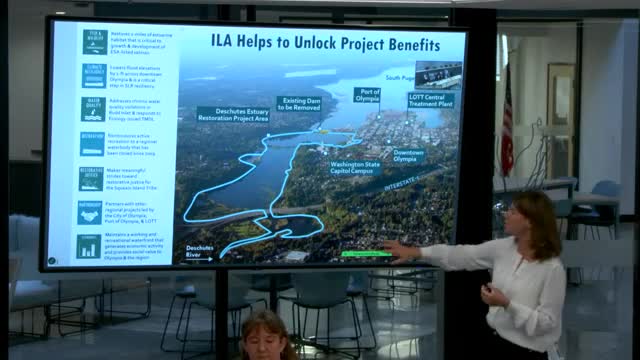Dam removal project promises ecological and economic revival
September 30, 2024 | Thurston County, Washington
This article was created by AI summarizing key points discussed. AI makes mistakes, so for full details and context, please refer to the video of the full meeting. Please report any errors so we can fix them. Report an error »

In a recent government meeting, officials discussed the long-awaited Capitol Lake Adaptive Management Plan, a collaborative effort involving Thurston County, the cities of Olympia and Tumwater, and various stakeholders, including the Squaxin Island Tribe. This initiative, which began in 1999, aims to address environmental concerns and improve water quality in the region by removing a dam and restoring two miles of estuarine habitat.
The removal of the dam is expected to yield significant ecological benefits, including enhanced salmon access to 40 miles of the Deschutes River and a reduction in flood elevations in Olympia by up to one foot. This project is also seen as a critical step in bolstering the area's resilience to sea level rise, particularly for downtown Olympia.
Officials highlighted the importance of this project in addressing chronic water quality violations in Bud Inlet, which have been exacerbated by the dam's presence. The initiative is part of a broader strategy to manage water quality and reduce regulatory pressures on local permit holders, which could otherwise lead to costly upgrades in water treatment facilities.
The meeting also touched on the recreational potential of the restored habitat, drawing comparisons to the Nisqually area, and emphasized the project's role in fostering restorative justice for the Squaxin Island Tribe. The collaborative nature of the project has been a key aspect, with local jurisdictions working together for over two decades to find a sustainable solution.
Concerns were raised about the impact of marine mammals, particularly sea lions, on salmon populations during the transition period. Officials discussed potential strategies to mitigate these impacts, although no definitive long-term solutions were proposed.
As the meeting concluded, participants acknowledged the necessity of moving forward with the estuary solution, which not only presents the most environmentally beneficial option but also proves to be the most cost-effective. The ongoing collaboration among local governments and stakeholders is crucial as they navigate the complexities of funding and governance for this significant environmental project.
The removal of the dam is expected to yield significant ecological benefits, including enhanced salmon access to 40 miles of the Deschutes River and a reduction in flood elevations in Olympia by up to one foot. This project is also seen as a critical step in bolstering the area's resilience to sea level rise, particularly for downtown Olympia.
Officials highlighted the importance of this project in addressing chronic water quality violations in Bud Inlet, which have been exacerbated by the dam's presence. The initiative is part of a broader strategy to manage water quality and reduce regulatory pressures on local permit holders, which could otherwise lead to costly upgrades in water treatment facilities.
The meeting also touched on the recreational potential of the restored habitat, drawing comparisons to the Nisqually area, and emphasized the project's role in fostering restorative justice for the Squaxin Island Tribe. The collaborative nature of the project has been a key aspect, with local jurisdictions working together for over two decades to find a sustainable solution.
Concerns were raised about the impact of marine mammals, particularly sea lions, on salmon populations during the transition period. Officials discussed potential strategies to mitigate these impacts, although no definitive long-term solutions were proposed.
As the meeting concluded, participants acknowledged the necessity of moving forward with the estuary solution, which not only presents the most environmentally beneficial option but also proves to be the most cost-effective. The ongoing collaboration among local governments and stakeholders is crucial as they navigate the complexities of funding and governance for this significant environmental project.
View full meeting
This article is based on a recent meeting—watch the full video and explore the complete transcript for deeper insights into the discussion.
View full meeting
